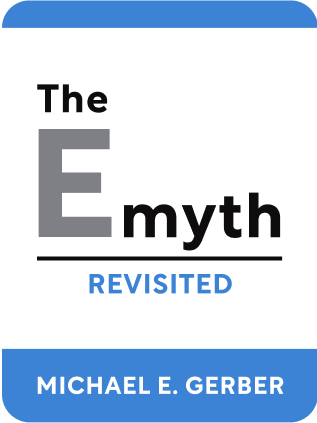

This article is an excerpt from the Shortform book guide to "The E-Myth Revisited" by Michael E. Gerber. Shortform has the world's best summaries and analyses of books you should be reading.
Like this article? Sign up for a free trial here .
What can small business leaders learn from the E-Myth book? How can it give a business a better chance to succeed?
In The E-Myth Revisited, Michael E. Gerber explains how focusing solely on the product—and just trying to work harder—undermines new businesses. The right approach is to view your business like a franchise—to systematize operations so that it no longer relies on you.
Read more to learn the primary principles from the E-Myth book.
The E-Myth Book’s Key Takeaways
Many people dream of quitting a job or leaving a boss they dislike and becoming their own boss by starting a business. Each year, a million new businesses are started. However, 40 percent fail within the first year and 80 percent fail within five years. Of those that last five years, more than 80 percent fail in the next five.
Underlying the high failure rate are persistent romantic notions about how businesses are born and what it takes to succeed. In the E-myth book, Gerber argues that new business owners typically fail because they focus on technical expertise rather than on developing business knowledge. They mistakenly think that knowing how to do a specific thing, such as baking pies, is all it takes to make a business work. But there’s much more to it. The important thing isn’t the commodity — what is produced — but how it’s produced. The business itself is the product.
The “E-Myth” of the book’s title refers to what Gerber calls the Entrepreneurial Myth that small businesses are founded by entrepreneurs with a great idea, capital to invest, and the business acumen to pull it off. The truth is that most small businesses are started by ill-equipped technicians.
#1: Three Roles
According to the E-myth book, a small business owner needs to cultivate and balance three roles or mindsets, all of which are necessary for running a business. The first is the technician mindset, which is where most small business owners begin and end. But this mindset by itself is insufficient. The other necessary roles are entrepreneur and manager. Here’s how they work:
- The entrepreneur role provides the vision, creativity, and energy that drive the business.
- The manager is a pragmatist who translates the vision into reality through planning and systems.
- The technician is an individualist and a doer who produces the product or service.
#2: Three Phases
The E-myth book discusses three phases — infancy, adolescence, and maturity — in which a typical small business develops. (However, many fail before reaching maturity.)
In the infancy phase, the owner wears the technician hat. The business is driven not by business needs but by what the owner wants, which is to produce something he enjoys making. The volume of work soon exceeds his capacity to get it all done. At this point, many businesses fail — the exhausted owner/technician gives up.
If the owner doesn’t give up in the infancy stage due to overwork, she moves into the adolescent phase in which she hires another technician and quickly off-loads responsibilities to that person while providing little oversight. Problems soon develop, so the owner jumps in again to do things herself. Soon the business reaches a crisis point where the owner feels she’s losing control.
Businesses can grow from infancy and adolescence to maturity as their owner learns and grows. But the most successful companies start out differently, as mature businesses already knowing where they’re going and how they’ll get there. The founders have business knowledge and an entrepreneur’s mindset.
Developing business knowledge is the crucial missing piece for most small business owners. If they don’t move out of their technician’s comfort zone to learn new skills and roles at the adolescence crisis point, business owners typically go one of three directions: they shrink the business (return to the infancy stage), go all out until they crash, or go into survival mode and barely hang on.
#3: The Franchise Movement
However, there’s a more effective and less painful route. The franchise movement, which started in the 1950s, has provided a “turn-key” model for successful business development that independent business owners can emulate.
The movement began when a milkshake machine salesman, Ray Kroc, visited a hamburger restaurant owned by two brothers named MacDonald in San Bernardino, California. At the restaurant, he found high school students producing identical burgers systematically and efficiently under the supervision of the owners. Kroc saw that this process could be replicated to continually make money and he persuaded the brothers to let him franchise it. He created McDonald’s, which became the world’s largest prepared food delivery system.
Franchising wasn’t a new idea — Kroc’s innovation was his “business format franchise,” a a new-business template that’s been widely adopted by other companies. Under business format franchising, the franchisor teaches the business format (marketing, selling, inventory, finance, personnel procedures) to the franchisee.
Kroc’s model format can be applied to small business development in any field.
#4: Building a Business
The E-myth book asserts that, in applying business format franchise principles, an owner must first think of his business in a new way — as though it were the prototype for thousands of others like it. He should imagine he’s going to franchise it, then create a model in which the parts — purpose, organization, management strategy, production systems and processes — can be replicated. In other words, he should create a model for a business that runs without him.
A business development program is the means for organizing or reorganizing a business into such a model or structure. There are seven components that you as an owner must work through:
- Personal objective: Determine your primary goal in life. Your business’s purpose should dovetail with your personal goal.
- Businessobjective: State what you want your business to look like and to accomplish. How much money does it need to make? How is it serving the need of your customers?
- Organizational plan: Create an organization chart reflecting what your organization will look like when the business is fully evolved. What specific functions does your business need? Create an operations manual for each position before hiring for it.
- Management plan: Create an operating philosophy that reflects why and how you do what you do. All your actions and your employees’ actions communicate this philosophy to your customers.
- People plan: Create an environment in your business where doing what needs to be done is important and gratifying to the people tasked to do it. Make each person’s expectations clear, and recognize them when they’ve achieved them.
- Marketing plan: Determine who your prime customers are, what they buy, and how to reach them. Research your customers through market data or customer surveys.
- Systems plan: Every part of your business is a system. Integrate the systems so they strengthen each other. Your hard systems (like office design and computers) should support your soft systems (people, documentation) and information systems (reports, forecasts), and vice versa.
#5: Ongoing Development
Once a business is organized and on track, development is an ongoing process that involves three activities: innovation, measurement of results, and execution. Here’s how the E-myth book describes them:
- Innovation: Most business owners think innovation means coming up with new products to increase sales. However, the franchise movement increases sales by applying innovation to the process — how a business does (or sells) things — rather than to what it produces. For example, changing the way your employee greets new customers from “Do you need help?” to “Have you been here before?” can open up conversations and increase sales.
- Measurement: Measuring the results or quantifying everything you do is the only way to know what’s working and what’s not.
- Execution: Once you innovate (find better ways to do things) and measure how you’re doing, you need to execute changes systematically, so that people know what to do and how to do it rather than acting on their own discretion
Implementing a systematic business development process transforms both owner and business. Her personal and business goals function in harmony, and she achieves the American small business dream that eludes so many others.
This article serves as an introduction to the E-myth book, a classic must-read for small business owners.

———End of Preview———
Like what you just read? Read the rest of the world's best book summary and analysis of Michael E. Gerber's "The E-Myth Revisited" at Shortform .
Here's what you'll find in our full The E-Myth Revisited summary :
- Why so many new business owners fail
- Why how you produce something is more important than what you produce
- The 7 components that you as an owner must work through






